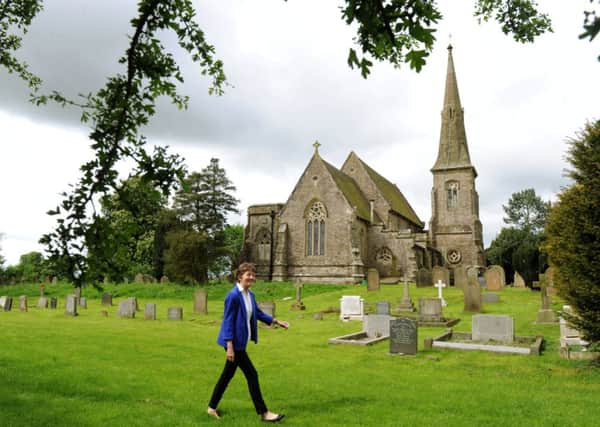Changing with the times in the battle to keep rural church open


Where local shops and pubs have fallen victim to the recession, religious buildings are providing a lifeline for isolated residents.
One such example is All Saints Church in Thirkleby, near Thirsk. Commissioned by Lady Frankland-Russell in 1851 on the family estate as a tribute to her late husband, and designed by the ‘rogue’ Victorian architect Edward Buckton Lamb, it is a building steeped in history.
Advertisement
Hide AdAdvertisement
Hide AdWith only two services a month and an average attendance of around 30 people relied upon to contribute towards substantial upkeep costs preserving this piece of local history is no mean feat.
But a small group of volunteers have brought in a number of new ideas designed to extend the reach of the church to the wider community.
Jill Gillanders, a churchwarden at All Saints, said: “When I first came here seven years ago the church was dying, numbers were even lower. I said if the church is going to survive it needs to find a way of welcoming people.
“We’ve lost the village shop and playing fields and we don’t have a pub anymore so we think it’s incredibly important to keep the parish church open. It is vital to the history of the area.
Advertisement
Hide AdAdvertisement
Hide Ad“We make every effort to keep numbers up, it’s crucial they don’t fall too low. You can’t have a service for one person.
“It’s about thinking outside the box and getting people to embrace the local church.”
Jazz nights, flower festivals, organ recitals and youth clubs are just some of the ways All Saints is luring Thirkleby locals.
The church has also been awarded £56,000 from the Heritage Lottery Fund towards a project to restore the bell tower and bring bell-bringing back to the community.
Advertisement
Hide AdAdvertisement
Hide AdIt involves removing the three existing bells and taking them to Whitechapel Bell Foundry in London for conservation and tuning, where experts will also cast two new bells. The sixth bell has been salvaged from an East London scrapyard.
Project leaders will be giving presentations to the local community, schools, Girl Guides, and Beavers throughout the restoration, focusing on the heritage of bells and the Frankland family, while also providing hands-on opportunities on a Wombel simulator to try bell ringing as a new hobby.
Ms Gillanders added: “Making bell-ringing a social activity everyone can get involved with is one way we are trying to welcome people. It can really make a difference in a rural community like ours.”
THE WORK of churches goes far beyond traditional Sunday services.
Advertisement
Hide AdAdvertisement
Hide AdOn average, the Church of England conducts over 1,000 weddings, 2,000 baptisms and 3,000 funerals. It also contributes to the education of education of one million children in its schools.
Last year a report revealed that 79 per cent of Anglican congregations formally volunteer compared with 49 per cent of the general public.
Churches embracing new era for Christian worship
Leeds and Ripon has closed six Anglican churches in the past decade, though some remain a place of worship for other denominations.
In some circumstances the C of E calls upon the Churches Conservation Trust to take over historic buildings no longer required as a house of worship.
Advertisement
Hide AdAdvertisement
Hide AdThe national charity currently runs 27 alongside local communities to ensure they are kept open and in use. The trust is not affiliated to any religion, but churches remain consecrated under their ownership.
Regional director Rosi Lister said: “The costs can be a hefty burden for one group of people, whereas we look at shared use of the building in special cases where there is historical or architectural significance.
“The trust negotiates with the C of E with each case, but the funding needed is significant and our government grants are decreasing.
“We tend to take around two or three churches in the region every year.
Advertisement
Hide AdAdvertisement
Hide Ad“Closures coming to us have been consistent since we began working in 1969 and I think it will continue that way.”
Research conducted by the C of E has Recent research from the C of E has highlighted ‘fresh expressions’, new forms of church which meet in a variety of venues such as cafes and drop-in centres as an area of growth, suggesting that Christianity can remain at the heart of communities even though the number church buildings or attendance for traditional Sunday worship may have depleted.
GraceSpace, a church group in Saltaire, Bradford began at a local cafe and now meets in the home of Revd Colin Blake in Shipley.
He said “We are church for people who don’t go to church. An experiment in emerging Christianity for the 21st-century. We practice the values of community, hospitality and celebration - and we love food.”
Advertisement
Hide AdAdvertisement
Hide AdOne example of a growing church is St Paul’s Church in Holgate, York, where the number of worshippers has increased steadily in recent years. Some weeks as many as 200 people, including many young families, turn out to Sunday services.
Reverend John Lee, rector at St Paul’s, said: “I think the Christian message is still immensely powerful, we just need to present it in ways which make it relevant to them. Sundays here are very informal, the message is that if you’ve got a young family no one is going to ‘shush’ you.
“Rather than imposing it on people we leave them to explore it and find their own way to belong.”